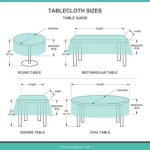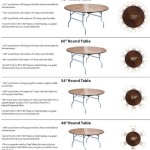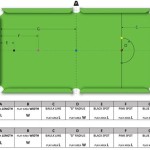Understanding Foldable Table Dimensions: A Comprehensive Guide
Foldable tables, renowned for their versatility and space-saving capabilities, are a staple in various settings, ranging from homes and offices to event venues and outdoor spaces. The inherent adaptability of these tables stems largely from their ability to be easily collapsed and stored, making them ideal for temporary setups or environments where space is at a premium. However, understanding the dimensions of foldable tables is crucial when selecting the right option for a specific need. This article provides a comprehensive overview of foldable table dimensions, exploring the various sizes, shapes, and the factors influencing these dimensions, enabling informed decision-making when acquiring a foldable table.
The dimensions of a foldable table are paramount because they directly impact its functionality and suitability for a particular task. A table that is too small may not provide sufficient surface area for its intended purpose, while an excessively large table can be cumbersome to transport and store. Furthermore, the dimensions influence the number of people that can comfortably be seated around the table. Therefore, meticulous consideration of the dimensions is essential to ensure that the selected table effectively meets the user's requirements and constraints.
Key Dimensions to Consider
When evaluating foldable table dimensions, several key measurements warrant careful attention. These dimensions collectively determine the overall size and usability of the table, impacting its functionality in different scenarios. Understanding these dimensions is crucial for selecting a foldable table that aligns precisely with the intended purpose.
Length: The length of a foldable table, typically measured along its longest side, dictates the amount of surface area it provides. Length is particularly crucial for tasks requiring a substantial workspace, such as crafting, displaying merchandise, or hosting large gatherings. Foldable tables are available in a wide range of lengths, from compact options suitable for individual use to extended models capable of accommodating multiple users. Common lengths include 4-foot, 6-foot, and 8-foot tables, each catering to different needs and spatial limitations.
Width: The width of a foldable table, generally measured perpendicular to its length, determines the depth of the usable surface. The width is a critical factor when considering the number of items that can be placed on the table simultaneously. For instance, a wider table is preferable for buffet setups or projects requiring ample space for materials. Similar to length, foldable tables are available in various widths, allowing users to choose a size that optimizes both surface area and portability. Typical widths range from 24 inches to 30 inches, with some specialized tables offering even greater widths.
Height: The height of a foldable table is the vertical distance from the floor to the top surface. This dimension significantly affects the comfort and ergonomics of the table, particularly when used for seated activities. Standard table heights generally fall within the range of 29 to 30 inches, which is suitable for most adult users. However, adjustable-height foldable tables are also available, offering greater versatility and adaptability to different user needs and preferences. These adjustable tables can be raised or lowered to accommodate various activities, such as standing tasks or use by individuals with differing heights.
Folded Dimensions: In addition to the dimensions when the table is in use, the folded dimensions are equally important, particularly for storage and transportation purposes. These dimensions describe the overall size of the table when it is collapsed for storage. Compact folded dimensions are desirable for individuals with limited storage space or those who frequently transport the table. Foldable tables are designed with various folding mechanisms that influence the compactness of the folded table, with some models folding in half and others featuring more intricate folding systems.
Standard Foldable Table Sizes and Applications
Foldable tables are manufactured in a range of standard sizes, each designed to cater to specific applications and user requirements. Understanding these standard sizes and their corresponding applications can aid in selecting the most appropriate table for a given purpose. The following outlines some common foldable table sizes and their typical uses.
4-Foot Foldable Tables: These tables are typically 48 inches in length and 24 to 30 inches in width. Due to their relatively compact size, 4-foot foldable tables are well-suited for individual use, small gatherings, or situations where space is limited. They are often used as student desks, craft tables, or display tables in smaller retail environments. Their portability makes them a popular choice for outdoor events or picnics.
6-Foot Foldable Tables: Measuring approximately 72 inches in length and 30 inches in width, 6-foot foldable tables offer a more generous surface area than their 4-foot counterparts. These tables are commonly used for catering events, buffets, or as workstations in offices or classrooms. They can comfortably accommodate six to eight people for dining or meetings. The increased surface area also makes them suitable for displaying merchandise at trade shows or markets.
8-Foot Foldable Tables: The largest standard size, 8-foot foldable tables, typically measure 96 inches in length and 30 inches in width. These tables provide ample space for large gatherings, banquets, or conferences. They can comfortably seat eight to ten people and are often used in event halls, community centers, or large offices. Their substantial size also makes them suitable for product demonstrations or as workbenches in workshops.
Round Foldable Tables: In addition to rectangular tables, round foldable tables are also available in various sizes. Common diameters range from 48 inches to 72 inches. Round tables are often preferred for social gatherings and events, as they promote conversation and create a more inclusive atmosphere. They are frequently used in restaurants, banquet halls, and wedding receptions. The folding mechanism typically involves the legs collapsing inward, allowing for relatively flat storage.
Factors Influencing Foldable Table Dimensions
The dimensions of foldable tables are not arbitrary; they are carefully determined by several factors, including the intended use, material construction, and structural design. Understanding these factors can provide insights into the rationale behind specific dimensions and aid in making informed choices when selecting a foldable table. Certain considerations must be taken for the longevity and stability of the table.
Intended Use: The primary determinant of a foldable table's dimensions is its intended use. A table designed for dining will typically have a standard height of 29 to 30 inches, while a table intended for standing tasks may be taller. Similarly, a table designed for displaying merchandise may have a wider surface area to accommodate more items. Manufacturers consider the common applications of foldable tables and tailor the dimensions accordingly to optimize functionality.
Material Construction: The materials used in the construction of a foldable table also influence its dimensions. For example, tables with heavier materials, such as solid wood, may require thicker legs and supports, which can affect the overall dimensions and weight of the table. Conversely, tables constructed from lightweight materials, such as plastic or aluminum, may be thinner and more compact. The material selection impacts the overall structural integrity and load-bearing capacity, which can influence the size and dimensions that are feasible.
Folding Mechanism: The design of the folding mechanism also plays a significant role in determining the folded dimensions of the table. Simple folding mechanisms, such as those where the legs simply fold inward, may result in a less compact folded size compared to more intricate folding systems. Some tables feature multiple hinges or telescoping legs that allow them to fold down into a remarkably small package. The choice of folding mechanism is often a trade-off between simplicity, ease of use, and the degree of compactness achieved in the folded state.
Weight Capacity: The weight capacity of a foldable table, which is the maximum weight it can safely support, also influences its design and dimensions. Tables with higher weight capacities typically require sturdier frames and thicker tabletops, which can result in larger overall dimensions. The weight capacity is a critical safety factor, and manufacturers carefully engineer the table to ensure it can withstand the intended load without compromising stability or structural integrity.
In summary, the dimensions of a foldable table are a critical consideration when selecting the right option for a specific need. By understanding the key dimensions, standard sizes, and the factors influencing these dimensions, users can make informed decisions and choose a foldable table that effectively meets their requirements and constraints. Careful evaluation of these factors ensures that the selected table provides the necessary surface area, portability, and stability for its intended purpose.

Realspace Molded Plastic Top Folding Table With Handles 29 H X 72 W 14 D Platinumcharcoal Office Depot

Lifetime 6 Ft Fold In Half Table Almond 80454 The Home Depot

Realspace Molded Plastic Top Folding Table 29 H X 48 W 24 D Platinum

Lifetime 6 Foot Folding Table Commercial

30x96 Bi Fold Table Rb 3096fh Adj Bizchair

Lifetime 182x76x74 5 Cm Folding Table Bricoinn

Catering Camping Heavy Duty Folding Trestle Table Picnic Bbq Party 4ft 5ft 6ft

Lifetime 4 Ft One Hand Adjustable Height Fold In Half Table Black 80879 The Home Depot

How To Choose The Best Folding Table For Your Event

Tradeshow Display 6 Almond Plastic Adjustable 24 36 Height Folding Table








